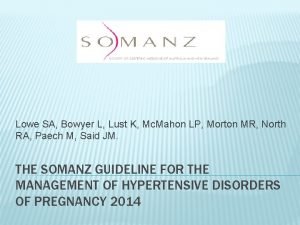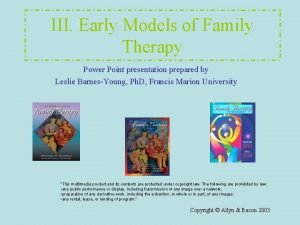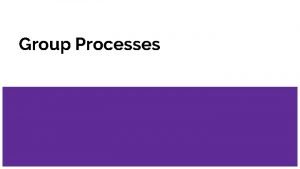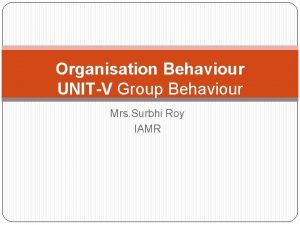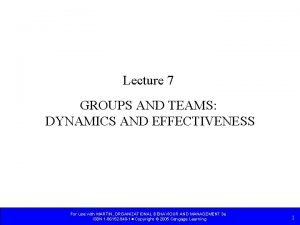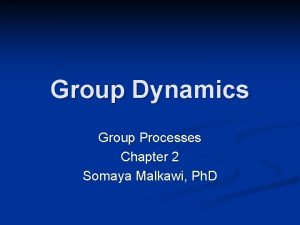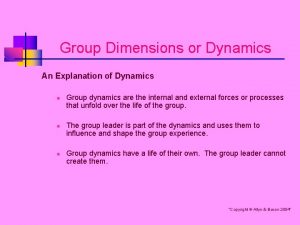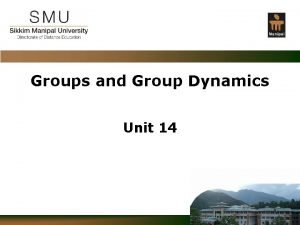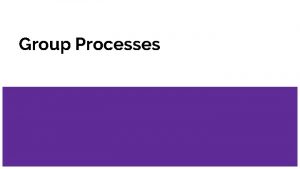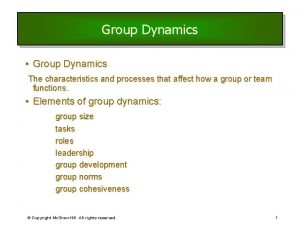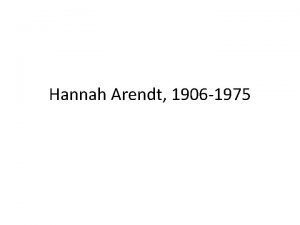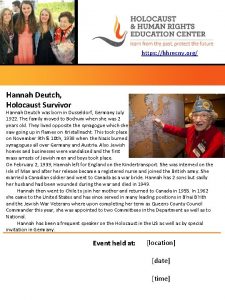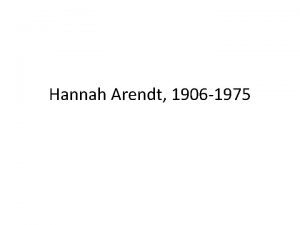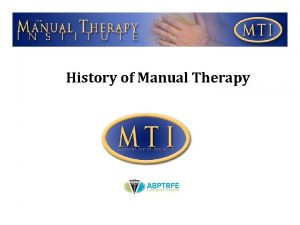Models and Dynamics of Group Therapy Hannah Lowe







































- Slides: 39

Models and Dynamics of Group Therapy Hannah Lowe, M. Ed. , LPC Signature Health

Introduction to Hannah Lowe Dynamics of Zoom Tid-bits to start • Mute • Chat • Questions Credit for course

Topic: Group Process and Techniques Section Credit Hours: 1. 5 Course Introduction Objectives: • Introduce models of group counseling • Identify the appropriateness of models of group counseling to treatment goals • Introduce group counseling dynamics • Participants • Facilitation • Practice the identification of group dynamics and practice addressing dynamics to support treatment

Outline • Qualities of a Group • Yalom’s Therapeutic Factors • Models of Group Counseling • • • Task/Work Psychoeducational Counseling Psychotherapy Mixed • Group Dynamics • • • Trust Support vs. confrontation Defensiveness and reluctant behavior Control Transference and countertransference Problem behaviors

Qualities of a Groups include two or more individuals who meet face-to-face or virtually Groups are interactive Group members are aware of belonging to the group Groups are purposeful- focused on achieving agreed upon goals Groups are interdependent (i. e. , depend on the whole) (Page & Jencius, 2009)

Qualities of a Group Yalom’s Therapeutic Factors Installation of hope Universality Altruism Imparting of information (or guidance) Family reenactment (Yalom, 1970, 1995)

Qualities of a Group Yalom’s Therapeutic Factors (cont. ) Self understanding Imitative behavior (identification) Group cohesiveness Interpersonal learning input Catharsis Interpersonal learning output Existential factors (Yalom, 1970, 1995)

Models of Group Counseling • Task/work • Counseling • Psychoeducational • Psychotherapy

Task/ Work Groups Foster “efficient and effective accomplishment of group tasks among people who are gathered to accomplish group task goals (ASGW, 2000, p. 330). Emphasize accomplishment and efficiency in successfully completing identified tasks through collaboration (Falco et al. , 2006)

Task/ Work Groups Run Best When… • the purpose of the group is clear to all participants, • process and content issues are balanced, • the systems of the group as a whole, leader, member, and subsets of members are recognized and acknowledged, • time is taken for culture building and learning about each other, • the ethic of collaboration, cooperation, and mutual respect is developed and nurtured, (Hulse-Killacky, & Donigian, 2001)

Task/ Work Groups Run Best When… • conflict is addressed, • feedback is exchanged, • leaders pay attention to the here-and-now, • members are active resources, • members learn to be effective and influential participants, • leaders exhibit a range of skills for helping members address task and human relations issues, • members and leaders take time to reflect on what is happening. (Hulse-Killacky, & Donigian, 2001)

Task/ Work Groups (Tasking) • Focus is on DOING • Group goal is specific • Emphasis placed on accomplishing the task. • Often product-oriented • Commonly labeled as “task-force”, “work group”, “ad hoc committee. ”

Psychoeducational Groups • Originally developed for use in educational settings, specifically public schools • “educational groups” • “guidance groups” • “Emphasizes using education methods to acquire information and develop related meaning and skills” (Brown, 1997, p. 1). • Can be preventive, growth oriented, or remedial in their purpose and focus

Psychoeducational Groups (Cont. ) • Used in a wide variety of settings outside of schools: • • • Hospitals Mental health agencies Correctional institutions Social service agencies Spiritual settings Universities

Psychoeducational Groups (Cont. ) • Psychoeducational groups include • • “discussion groups guided group interactions recovery groups support groups orientation groups educational groups student-centered learning groups” (Rivera et al. , 2004, p. 391)

Psychoeducational Group (Cont. ) • Elements of designing and planning for a successful psychoeducational group: • • • stating the purpose establishing goals setting objectives selecting content designing experiential activities Evaluating (Furr, 2000)

Psychoeducational Groups (Cont. ) • Stress growth through knowledge (ASGW, 1991, 2000) • Emphasize transmitting, discussing, and integrating factual knowledge (Rivera et al. , 2004) • Content includes but is not limited to personal, social, vocational, and educational information.

Counseling Groups • Preventative, growth oriented, and remedial • “Generally considered to be a treatment mode that is equal in effectiveness to individual counseling” (Stockton, Morran, & Krieger, 2004, p. 65) • May be referred to as interpersonal problem-solving groups.

Counseling Groups (Cont. ) • Counseling groups emphasize improvement of interpersonal relationships and the intrapersonal growth of members. • Although goals are personal, the group as a whole may also share them. • Often, topics covered are developmental or situational.

Psychotherapy Groups • Address “personal and interpersonal problems of living. . . among people who may be experiencing severe and/or chronic maladjustment” (ASGW, 2000, p. 331) • Are remedial in nature and emphasize helping people with serious psychological problems of long duration by confronting them with “their unconscious conflicts so that they may be resolved” (Lev. Wiesel, 2003, p. 240)

Psychotherapy Groups (Cont. ) • Found most often in mental health facilities, such as clinics and hospitals • Emphasize therapy by the group rather than therapy in the group (Grossmark, 2007) • May be open-ended (admitting new members at any time) or closed-ended (not admitting new members after the first session). • A primary aim is to reconstruct or rectify the personalities or intrapersonal function of members of the group (Brammer et al. , 1993; Gazda et al. , 2001)

Psychotherapy Group Leaders • Are mental health experts with specialized training and expertise in dealing with people with emotional problems • Often operate from a theoretical position.

Mixed Groups • Mixed groups encompass multiple ways of working with group members and may change their emphasis at different times in the development of the group. • Self-help and support groups, as an example, are often psychoeducational, psychotherapeutic, and task driven. Leadership may be by a professional helper or support group member.

Models of Groups Type Task/Work Counseling Psychoeducation Psychotherapy Purpose Doing Growing Learning Transforming Outcome Tasking Relating Acquiring Contacting

Trust Support vs. confrontation Group Dynamics Defensiveness and reluctant behavior Silence and Lack of Participation Problem behaviors

Trust entails a sense of safety= intimacy Trust Signs of developing trust: Expressing feelings without fear of censure Deciding goals and personal areas of exploration Members focusing on self not others Personal disclosure Mistrust: anger, suspicion, unwilling to reflect on feelings, and

Modeling Maintaining trust Facilitating Trust Attending and listening Understanding nonverbal behaviors Caring Confrontation Respect Empathy Self-Disclosure Genuineness

Caring Confrontation • Opportunity to invite members to examine some discrepancy between what they are saying and doing or what they are saying and their body language • Checking in (Interpretation of confrontation)

Confrontation Example • Claire is very willing to speak on everything and constantly brings herself in on others’ work. • An ineffective confrontation by a group leader is this: “I want you to be quiet and let others in here talk. ” • An effective leader confrontation is this: “Claire, I appreciate your willingness to participate and talk about yourself. However, I’m concerned that I have heard very little from several others in the group, and I want to hear from them too. ”

Defensiveness and Reluctance • Connected to Trust • Bringing material into conscious awareness isn’t safe • Trust the wisdom of reluctance

Silence • Many reasons for nonparticipator behavior • Showing respect and waiting to be called on by the leader • Believing that they have nothing to add or worthwhile to say • Believing they shouldn’t talk about themselves • Uncertainty about how the group process works (protocol for sharing) • A protection against oppression • Fear of rejection • Lack of trust

Problem Behaviors Monopolistic Behavior Storytelling Questioning Advice giving Dependency Offering pseudosupport Hostile behavior Acting superior Socializing Intellectualizing Members becoming assistant leaders

Working with Difficult Behaviors • Leaders will describe the observed behavior and the impact this behavior has on the group. • Keep the behaviors clear as behaviors & not personalized • Avoid sarcasm • Educate the members about how the group works • Encourage members to explore their defensiveness • Avoid labeling, instead describe • Avoid stereotyping • Find ways to explore conflicts rather than avoid • Be congruent about feelings and discuss therapeutically

Example In your chat, please type in any type of dynamic or factor your observing.

Example • In your chat, please type in any type of dynamic or factor your observing.

Example • In your chat, please type in any type of dynamic or factor your observing.

Example

Extra Resources • Group Process playlist https: //www. youtube. com/playlist? list=PL 0 sx 7 d. VJFLEA 7 fqufs. Bc. Qx Vm. Ee. VUQSgos • Group Counseling Demonstrations Playlist • https: //www. youtube. com/playlist? list=PLVos 6 g_w. Pu. Qf_MIk. Ux_x m. ZGT 4 jena. G 13 n

References • Corey, M. S. , Corey, G. , and Corey, C. (2018). Groups: Process and Practice 10 th edition, Cengage. • Page, B. J. , & Jencius, M. J. (2009). Groups: Planning and leadership skills. Houghton Mifflin Company. • Yalom, I. D. (1970). The theory and practice of group psychotherapy. Basic Books. • Yalom, I. D. (1995). The theory and practice of group psychotherapy (4 th ed. ). Basic Books.
 Bernie lowe and associates
Bernie lowe and associates What is the difference between models and semi modals
What is the difference between models and semi modals Distinctive image features from scale-invariant keypoints
Distinctive image features from scale-invariant keypoints Feature transform
Feature transform Feature transform
Feature transform David g lowe
David g lowe Löwe lateinischer name
Löwe lateinischer name Dr robert lowe
Dr robert lowe Procare citrus floor cleaner lowe's
Procare citrus floor cleaner lowe's Susan suchting lowe
Susan suchting lowe Feature transform
Feature transform Jason lowe-power
Jason lowe-power Prof sandra lowe
Prof sandra lowe What year was lowes founded
What year was lowes founded Gilly salmon 5 stage model
Gilly salmon 5 stage model Psychodynamic and humanistic therapies have in common
Psychodynamic and humanistic therapies have in common Bioness integrated therapy system price
Bioness integrated therapy system price Psychoanalytic therapy is to as humanistic therapy is to
Psychoanalytic therapy is to as humanistic therapy is to Models of family therapy ppt
Models of family therapy ppt Communication and interaction patterns
Communication and interaction patterns Group dynamics and communication
Group dynamics and communication Group processes and dynamics
Group processes and dynamics Function of group dynamics
Function of group dynamics Dynamics crm user group
Dynamics crm user group Nature of an organization
Nature of an organization Group dynamics in organisational behaviour
Group dynamics in organisational behaviour What is group dynamics in organisational behaviour
What is group dynamics in organisational behaviour Bion group dynamics
Bion group dynamics Model of group dynamics
Model of group dynamics Bion group dynamics
Bion group dynamics Function of group dynamics
Function of group dynamics 5 stages of group dynamics
5 stages of group dynamics Meaning of group dynamics
Meaning of group dynamics Group dynamics in social work
Group dynamics in social work Group 4 project ib
Group 4 project ib Group dynamics definition
Group dynamics definition Types of group dynamics
Types of group dynamics Inhibited group dynamics
Inhibited group dynamics Group dynamics definition
Group dynamics definition Small group dynamics
Small group dynamics









